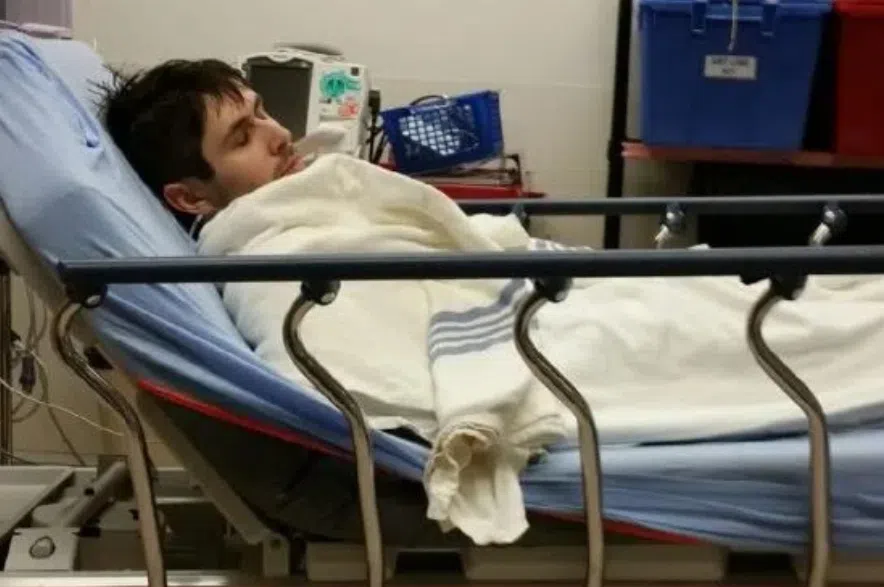It’s just a piece of equipment, but for one Regina man, it would change his life if he could afford it.
Tyler Parker was diagnosed with diabetes 35 years ago and has since been hospitalized enough times to know what to watch for when his blood sugar spikes.
Read more:
- Federal health minister non-committal on signing more pharmacare deals
- Scott Moe’s Sask. Party promises to extend diabetes coverage if re-elected
“It’s kind of a weird thing to say, but I can feel my feet almost tingle,” he said, adding that he gets thirsty, tired and nauseous when his blood sugar levels are off.
Parker might be familiar with his symptoms now, but he’s been admitted to an intensive care unit before and, most recently, spent two days in an emergency room.
He said that the latest hospital stint came after the current system regulating his blood sugar failed to deliver his insulin.
That failure left Parker without proper sleep for nearly two days, being woken up every hour to have his blood sugar tested.
Whenever he wanted to move, he had to consider the three IV lines he was hooked up to.
He said the Regina General staff wanted to admit him into the hospital, but had to keep him in the emergency department because there were no beds.
By the time he was discharged, Parker had lost 48 hours and $300 to the hospital stay, having paid for emergency supplies and insulin.
But, he thinks the whole ordeal could have been prevented.

Parker says other provinces cover one or both devices in the closed-loop diabetes system, but Saskatchewan’s government doesn’t cover his costs for either. (Tyler Parker/submitted)
Coverage for devices decided by age
The current insulin system that Parker uses is “outdated,” he says
He wants to upgrade to the closed-loop system of the Dexcom G7 and OmniPod 5. The former monitors blood sugar levels, while the latter automatically adjusts insulin dosage based on that information.
When used together they would, “hopefully give you more of a life like someone without diabetes, where you don’t even think about your blood sugar,” Parker said.
In addition to providing him with a, “normal life,” he said the two modern technologies would have caught his rising blood sugar before he needed to go to the hospital.
“It would have given me warnings that I wasn’t getting insulin. I could see my blood sugar rise,” he said.
The problem is, he can’t get the equipment.
The Dexcom G7, which monitors blood sugar levels, is only covered for people aged under 25 or over 65 in Saskatchewan.
The no-cost coverage came into effect on April 1, providing advanced glucose monitoring to an additional 9,700 diabetes patients in Saskatchewan, according to the Ministry of Health.
At age 40, Parker will need to wait another 25 years until he’d be eligible for the G7.
Parker said the OmniPod 5, designed to work with the G7, it isn’t currently covered under the province’s Insulin Pump Program.
While many private health insurance covers the system, according to Parker there are still limitations, and he currently doesn’t have private coverage.
He said paying for the closed-loop system out of pocket would set him back thousands of dollars.
Another option would be getting special coverage from the provincial government, but Parker said that would require a doctor, a nurse, and a lot of sign offs.
“If it was just covered, it would be quite a bite easier,” he said.
Criteria could be expanded, government says
Parker has tried reaching out to the Ministry of Health to explain his need for this technology to no avail.
In a written statement, the Ministry of Health did not touch on the Dexcom G7 or OmniPod 5.
It did, however, note that, “in time, there will be further expansions to the eligibility criteria,” like those placed around the G7.
The ministry added that in the 2025-26 Provincial Budget, $84.1 million was allocated for diabetes supports, which is an increase of $27.8 million from the previous fiscal year.
Parker wants the government to provide coverage for diabetes technology for all ages and make more modern options available.
It’s about more than just keeping him out of the hospital, he said, it’s about giving him access to “life-saving technology.”
Read more:











